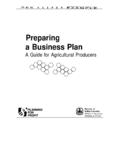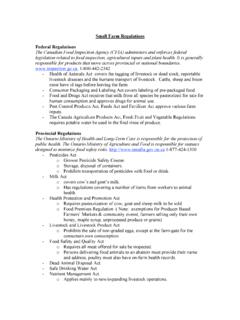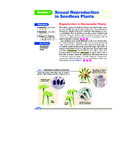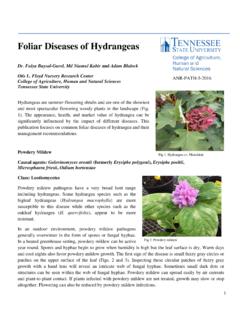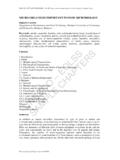Transcription of Role of copper and sulfur based fungicides in organic ...
1 The role of copper and sulfur based fungicides in organic vegetable production Ahmed Bilal World Crops Agronomist FarmStart After planting vegetable crops in the field or greenhouse, it is sometimes necessary to apply some sort of protectant or eradicant spray or dust material for disease control. Inorganic disease control materials primarily copper and sulfur based fungicides , have been used for centuries. These inorganic chemicals are generally inexpensive and widely available, and fulfill the two most important criteria in disease management: efficacy with minimal ecological impact. However, it must be stressed that improper use of any chemical, synthetic or organic , will result in a failure of control and will have negative environmental consequences. Care should always be taken in applying chemical treatments. Effective use of organic fungicides (or any fungicide for that matter) requires a solid strategy of integrated plant management.
2 As opposed to focussing on the pest or pathogen in a traditional integrated pest management (IPM) program, integrated plant management focuses on identifying the right plant for the site, and developing management strategies aimed at keeping that plant healthy. The backbone of integrated plant management includes carefully matching the plant to the soil type, sunlight levels and watering conditions, and practicing proper sanitation and appropriate fertilization and pruning when necessary. All of these strategies work together to prevent disease problems from developing. Prevention is the key word here. Preventing disease is essential to successful organic vegetable production because established populations of plant pathogens don't respond well to any chemical, organic or synthetic. The fungicides and bactericides discussed here all have low acute toxicity to both birds and mammals (including humans).
3 But this doesn't mean you should use them indiscriminately. copper and sulfur based chemicals should be used with caution for the sake of your plants, and in the case of the copper based fungicides , to prevent groundwater contamination ( copper is a heavy metal and toxic to fish). As always, follow label instructions carefully when applying any inorganic material. sulfur Early in agricultural history, the Greeks recognized the efficacy of sulfur in controlling rust on wheat. sulfur can be used as a preventive fungicide against powdery mildew, rose black spot, rusts and other diseases. The key to its efficacy is that it prevents spore germination. For this reason, it must be applied prior to disease development for effective results. sulfur can be applied as a dust or purchased in liquid form. It is also available as a wettable powder; it is up to you to decide which form you wish to use.
4 Do not use sulfur if you have applied an oil spray within the last month the combination is phytotoxic (plant killing). Likewise, remember to avoid using sulfur when temperatures are expected to exceed 80 F. Finally, there are certain sulfur shy plants, including cucurbits, which should never be treated with sulfur . Lime sulfur is formed when lime is added to sulfur to help it penetrate plant tissue. It is more effective than elemental sulfur at lower concentrations. However, it gives off an odor of rotten eggs, which usually discourages its use over extensive plantings. copper Bordeaux mixture has been successfully used for over 150 years on fruits, vegetables and ornamental plants. Unlike sulfur , Bordeaux mixture is both fungicidal and bactericidal. As such, it can be effectively used against diseases such as leaf spots caused by bacteria or fungi, powdery mildew, downy mildew and various anthracnose pathogens.
5 Bordeaux mixture s tenacity in adhering to plants regardless of spring rains is one reason why it is so effective. Bordeaux mixture contains copper sulfate, which is acidic, neutralized by lime (calcium hydroxide), which is alkaline. Bordeaux mixture comes in several formulations. One of the most popular, effective and least phytotoxic formulations for general home garden and orchard use is the 4 4 50 formulation (These numbers translate into four pounds copper sulfate and four pounds lime in 50 gallons of water). These formulations were developed in recognition of the fact that copper , like sulfur , is phytotoxic, and the level of toxicity is related to the age of plant tissue being treated. If Bordeaux mixture is applied in spring after the tree breaks dormancy (to prevent infection by the fire blight bacteria, Erwinia amylovera), a weaker, more dilute formulation should be used to reduce the risk of plant injury.
6 Some labels will recommend twice as much fungicide, which translates into an 8 8 50 formulation, for other diseases or late season application. Bordeaux mixture can be applied as either a dust or purchased as a liquid formulation. Some sensitive plants require diluting the product to one half strength (depending on the product used see label) to avoid phytotoxicity. Application of Bordeaux during hot weather (above 85 F) may cause yellowing and leaf drop. Additionally, leaf burn can occur if it rains soon after a Bordeaux application. Many growers address this problem by applying spray oil to the spray mixture, which reduces the likelihood of burn. Over 400 chemical pesticides are routinely used in conventional farming, and studies show that chemical residues are often present in non organic food. As natural occurring elements, sulfur and copper both break down more quickly than chemical pesticides, and can therefore be used safely (providing care is taken in their application), without any residual effect.
7

